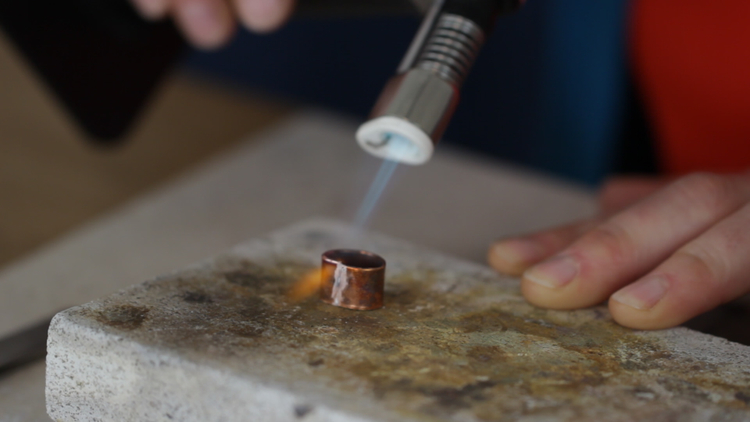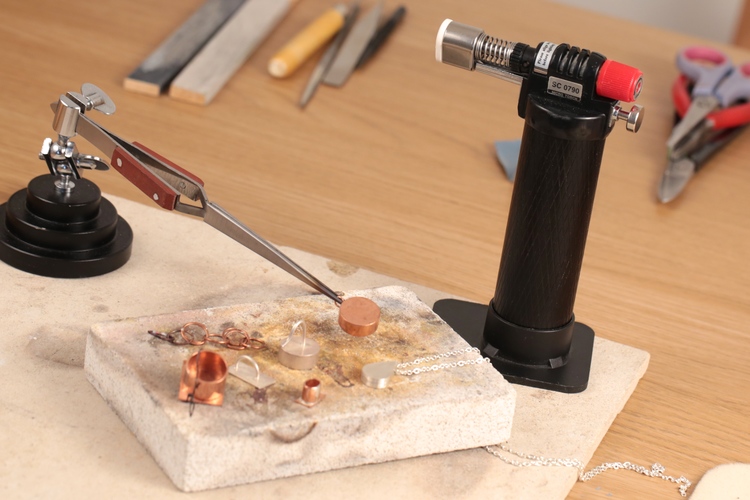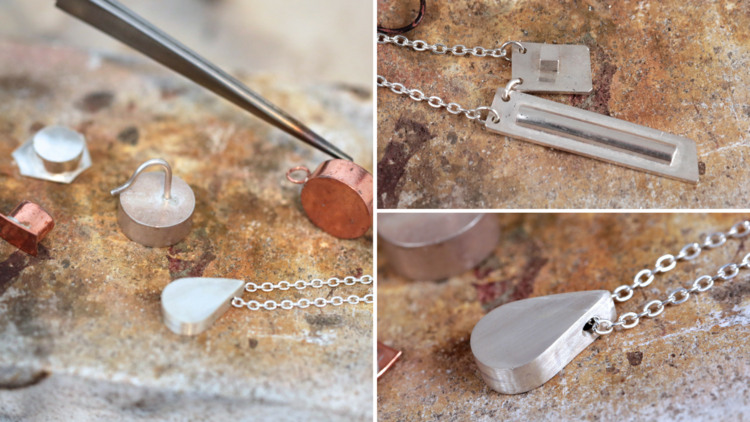Why I love soldering
by Karen Young
Soldering is a process that got me so excited the first time I was shown how to do it - I immediately saw a world of new design ideas open up to me!
Like many people, my jewellery making journey started with beading and wire wrapping. Then 5 years ago I decided to take a silver jewellery class as I felt I had reached the stage where I needed to learn a new skill to keep developing my designs.
My first soldering project was a soldered silver ring, which is probably most people’s first soldering project. I still wear and love the ring that I made that day. Some 5 years later it still gives me a bit of a thrill when the solder flows!
My very first soldered siler ring!
So what is it that I love about soldering?
Soldering is the process in which two or more pieces off metal are joined together by melting and putting a filler metal (solder) into the joint. Solder has a lower melting point than the adjoining metal which enables you to join the two without melting the main metals. The process of soldering causes the molecules of the silver and solder to marry creating a nice and strong bond - pretty cool isn't it?
Until the day I learned how to solder, I was limited in terms of how I could join metals and materials and relied on wire wrapping and other cold connections. This meant having to adapt my designs to tally with my skillset. Learning how to solder enabled me to realise my designs exactly the way I had envisaged them and move from largely flat jewellery to 3D jewellery incorporating gemstone settings. I still use cold connections where appropriate, but these days I primarily solder components together to create my designs. Even being able to solder my jump rings shut makes my jewellery more secure and durable which is important to me when making keepsake jewellery that is precious to the recipient.
Learning to solder did take me a bit of time and practice to really learn how to consistently solder, and I am sure that I have made every beginners mistake in the book (not enough heat, poor joins, not heating the piece evenly etc). But, with a bit of time, effort and practice I can now solder with confidence and have created my own brooch fittings from scratch, created hinged lockets and my own gemstone settings. That is the beauty of a skill like soldering - it is easy to learn how to do it well as it is all science!
That’s not to say I don't have the odd bad soldering day - I think it happens to us all occasionally - but it is usually because I am tired and am trying to do too much. When it happens I make myself take a break and go back to it later - that normally sorts everything out and the solder starts flowing again and I don't melt anything!
And soldering Sterling Silver or the likes of copper are by far the hardest - soldering gold (or even argentium) is far easier as you only need to heat the area being joined as opposed to Sterling Silver where you need to bring the entire piece to the same temperature at the same time. So if you can solder Sterling Silver you can solder anything!
I tend to use hard solder wherever possible as it is the best colour match to Sterling Silver - so that means I need to be careful when doing multiple joins (I use thermogel or if pushed rouge powder to stop out joins to stop the original solder remelting). You do get a little bit of protection using just hard solder as the original solder once it has flowed needs to reach a slightly higher melting point each time it flows again. This means the new solder should flow first, but I don't tend to rely on that principle for tricky soldering jobs.
I also love the flexibility that soldering offers. There are times where I use the minimum amount of solder possible (chain making, soldering jump rings) etc, and other times where I want to use excess solder to allow me to flood the join i.e. soldering a bezel to a ring shank. I have complete control
I don't tend to use solder paste a huge amount. I only really use it for chains and jump rings as it can be a little bit unpredictable in terms of how it flows. I tend to roll down regular solder in the rolling mill, and cut tiny pallions when I need them which means I have minimal waste. Lots of people love using borax as flux but I must admit a preference for Auflux. As I tend to work in gold and argentium silver, this means I only need to have one type of flux to hand although there are times when I miss the stickiness of borax which can come in handy.
I like to clean my solder using a brillo pad before I cut it so that the solder is nice and clean and will flow more easily.
So for those of you who are struggling to master solder I would say give it time, and practice lots. As I said before soldering is science and is something you can learn to do well. You will make mistakes and you will melt some stuff -that is all part of the learning process! And there are lots of tips and techniques that will help you become more consistent with your soldering and create some amazing designs that you had never thought would be possible!
I asked Jewellers Academy tutor and soldering pro, Hayley Kruger, to put together a FREE troubleshooting guide for soldering. So if you would like a handy cheat sheet that you can print off and keep to hand to help you sort out your soldering issues click here now.
And if you want a bit more help with mastering your soldering then do check out the new online Soldering Masterclass course by Jewellers Academy.




